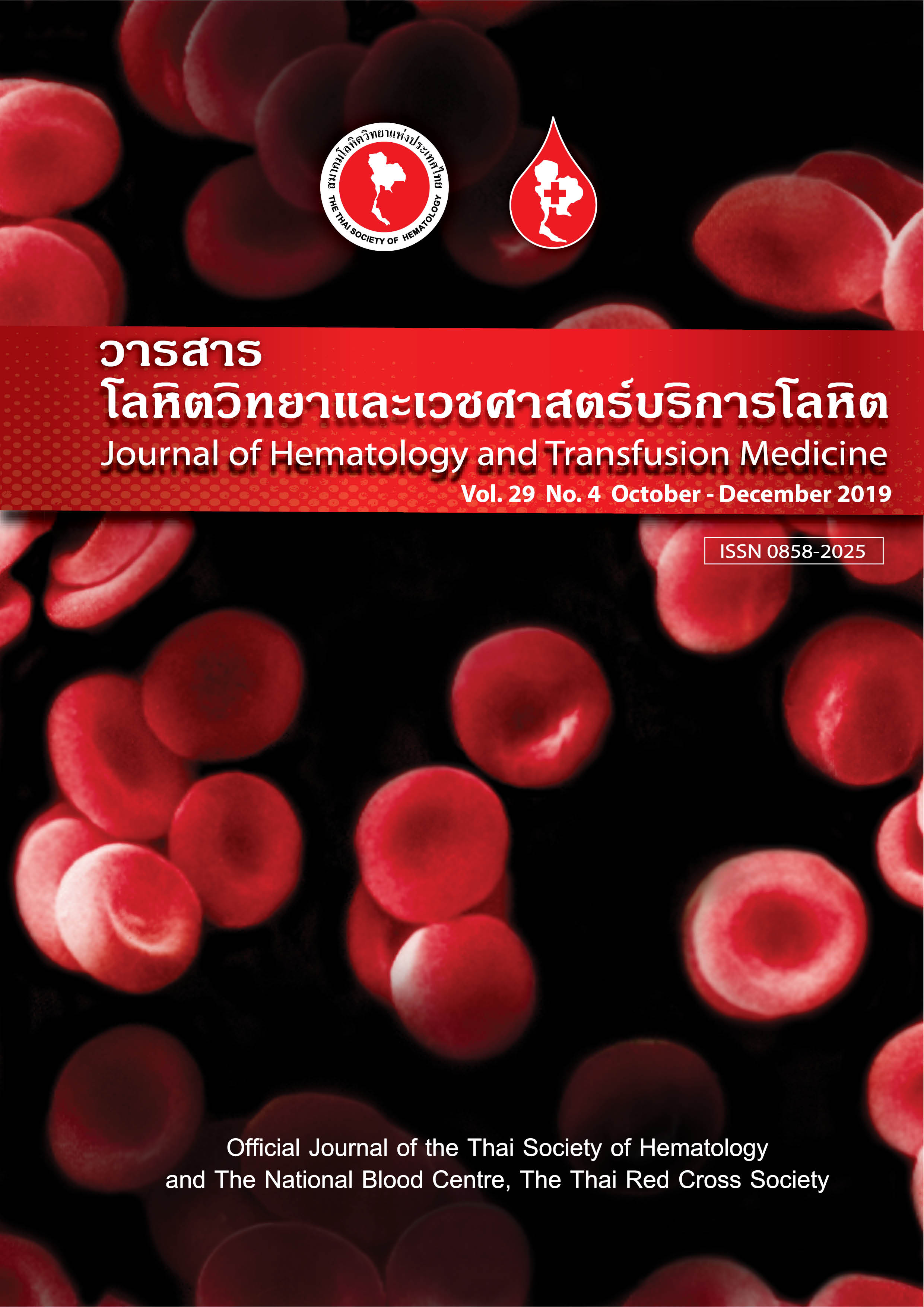การเปลี่ยนแปลงของสัดส่วน hemoglobin (Hb) E และ Hb F จากการมียีน alpha-thalassemia ร่วม ในกลุ่มธาลัสซีเมียที่มี Hb E เป็นส่วนประกอบ
Keywords:
การตรวจวิเคราะห์ฮีโมโกลบิน, แอลฟาธาลัสซีเมีย, ฮีโมโกลบินอีAbstract
Background: Phenotypes of specific hemoglobin (Hb) could be altered by a co-inheritance of alpha thalassemia which commonly found in the population.
Objective: The study aimed to demonstrate phenotypic alteration of each Hb fraction from an alpha thalassemia co-inheritance in Hb E related disorders.
Method: The study was conducted using blood specimens and records of Hb analysis determined by high-performance liquid chromatography from a thalassemia prenatal control program at the Thalassemia Research Unit, Naresuan University Hospital between February 2014 and January 2017. Hb E related disorders were identified comprising 116 Hb E/beta thalassemia compound heterozygotes, 403 Hb E homozygotes and 332 Hb E heterozygotes. DNA method to detect alpha0- thalassemia (Southeast Asian and Thai deletion) and alpha+-thalassemia (-3.7 kb and -4.2 kb deletions) alleles were determined in all samples using gap-polymerase chain reaction (PCR) and real-time PCR. Fractions of Hb E and F were compared between specific Hb E related disorders with different copy numbers of alpha globin genes.
Result: In Hb E/beta thalassemia compound heterozygote, fractions of Hb E substantially increased correlated with lesser copy numbers of alpha-globin genes, while fractions of Hb F changed in the opposite direction. Fractions of Hb E and Hb F in other Hb E related disorders were significantly affected by an alpha-thalassemia co-inheritance.
Conclusion: Our study demonstrated a pattern of phenotypic alteration of Hb fractions in specific Hb E related disorders with different copy numbers of alpha globin genes. The misdiagnosis problem could have occurred in prenatal control for beta-thalassemia, which relies on phenotypic diagnosis using Hb analysis.
Downloads
References
2. Tachavanich K, Viprakasit V, Chinchang W, Glomglao W, Pung-Amritt P, Tanphaichitr VS. Clinical and hematological phenotype of homozygous hemoglobin E: revisit of a benign condition with hidden reproductive risk. Southeast Asian J Trop Med Public Health. 2009;40:306-16.
3. Rees DC. Hemoglobin F and hemoglobin E/beta-thalassemia. J Pediatr Hematol Oncol. 2000;22:567-72.
4. Pakdee N, Yamsri S, Fucharoen G, Sanchaisuriya K, Pissard S, Fucharoen S. Variability of hemoglobin F expression in hemoglobin EE disease: Hematological and molecular analysis. Blood Cells Mol Dis. 2014;53:11-5.
5. Walsh PS, Metzger DA, Higuchi R. Chelex 100 as a medium for simple extraction of DNA for PCR-based typing from forensic material. Biotechniques. 1991;10:506-13.
6. Pornprasert S, Phusua A, Suanta S, Saetung R, Sanguansermsri T. Detection of alpha-thalassemia-1 Southeast Asian type using real-time gap-PCR with SYBR Green1 and high resolution melting analysis. Eur J Haematol. 2008;80:510-4.
7. Wong P, Srichaiya A, Suannum P, Charoenporn P, Jermnim S, Chan-In M, et al. Frequency of hemoglobin E/β-thalassemia compound heterozygotes with low hemoglobin F phenotype among cases with a diagnosis of hemoglobin E homozygote, determined by high-performance liquid chromatography, in prenatal control program for β-thalassemia. Ann Hematol. 2017;96:1763-5.
8. Nuinoon M, Makarasara W, Mushiroda T, Setianingsih I, Wahidiyat PA, Sripichai O, et al. A genome-wide association identified the common genetic variants influence disease severity in beta0-thalassemia/hemoglobin E. Hum Genet 2010;127:303-14.
9. Sanchaisuriya K, Fucharoen G, Sae-ung N, Jetsrisuparb A, Fucharoen S. Molecular and hematologic features of hemoglobin E heterozygotes with different forms of α-thalassemia in Thailand. Ann Hematol. 2003;82:612-6.
10. Chaibunruang A, Prommetta S, Yamsri S, Fucharoen G, Sae-Ung N, Sanchaisuriya K, et al. Molecular and hematological studies in a large cohort of α0-thalassemia in northeast Thailand: data from a single referral center. Blood Cells Mol Dis. 2013;51:89-93.
11. Steinberg M, Adams J. Hemoglobin A2: Origin, Evolution, and Aftermath. Blood. 1991;78:2165-77.
12. Singha K, Fucharoen G, Sanchaisuriya K, Fucharoen S. EE score: an index for simple differentiation of homozygous hemoglobin E and hemoglobin E-β0-thalassemia. Clin Chem Lab Med. 2018;56:1507-13.
13. Pornprasert S, Tookjai M, Punyamung M, Kongthai K. A Formula to Identify Potential Cases of β-Thalassemia/Hb E Disease Among Patients With Absent Hb A, Hb E > 75% and Hb F Between 5 and 15%. Lab Med. 2019;50:158-62.



